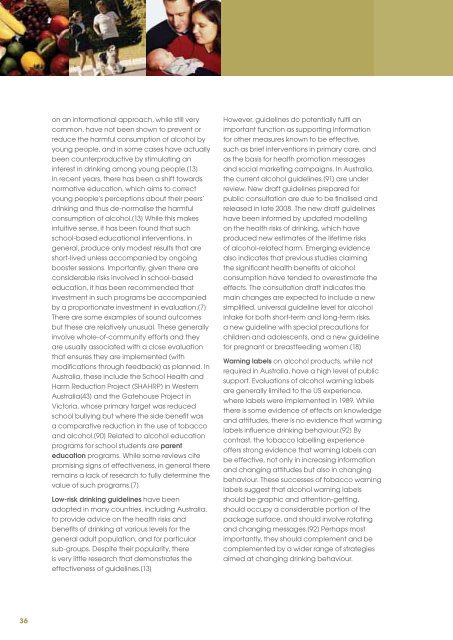alcohol-jul09
alcohol-jul09
alcohol-jul09
You also want an ePaper? Increase the reach of your titles
YUMPU automatically turns print PDFs into web optimized ePapers that Google loves.
on an informational approach, while still very<br />
common, have not been shown to prevent or<br />
reduce the harmful consumption of <strong>alcohol</strong> by<br />
young people, and in some cases have actually<br />
been counterproductive by stimulating an<br />
interest in drinking among young people.[13]<br />
In recent years, there has been a shift towards<br />
normative education, which aims to correct<br />
young people’s perceptions about their peers’<br />
drinking and thus de-normalise the harmful<br />
consumption of <strong>alcohol</strong>.[13] While this makes<br />
intuitive sense, it has been found that such<br />
school-based educational interventions, in<br />
general, produce only modest results that are<br />
short-lived unless accompanied by ongoing<br />
booster sessions. Importantly, given there are<br />
considerable risks involved in school-based<br />
education, it has been recommended that<br />
investment in such programs be accompanied<br />
by a proportionate investment in evaluation.[7]<br />
There are some examples of sound outcomes<br />
but these are relatively unusual. These generally<br />
involve whole-of-community efforts and they<br />
are usually associated with a close evaluation<br />
that ensures they are implemented (with<br />
modifications through feedback) as planned. In<br />
Australia, these include the School Health and<br />
Harm Reduction Project (SHAHRP) in Western<br />
Australia[43] and the Gatehouse Project in<br />
Victoria, whose primary target was reduced<br />
school bullying but where the side benefit was<br />
a comparative reduction in the use of tobacco<br />
and <strong>alcohol</strong>.[90] Related to <strong>alcohol</strong> education<br />
programs for school students are parent<br />
education programs. While some reviews cite<br />
promising signs of effectiveness, in general there<br />
remains a lack of research to fully determine the<br />
value of such programs.[7]<br />
Low-risk drinking guidelines have been<br />
adopted in many countries, including Australia,<br />
to provide advice on the health risks and<br />
benefits of drinking at various levels for the<br />
general adult population, and for particular<br />
sub-groups. Despite their popularity, there<br />
is very little research that demonstrates the<br />
effectiveness of guidelines.[13]<br />
However, guidelines do potentially fulfil an<br />
important function as supporting information<br />
for other measures known to be effective,<br />
such as brief interventions in primary care, and<br />
as the basis for health promotion messages<br />
and social marketing campaigns. In Australia,<br />
the current <strong>alcohol</strong> guidelines.[91] are under<br />
review. New draft guidelines prepared for<br />
public consultation are due to be finalised and<br />
released in late 2008. The new draft guidelines<br />
have been informed by updated modelling<br />
on the health risks of drinking, which have<br />
produced new estimates of the lifetime risks<br />
of <strong>alcohol</strong>-related harm. Emerging evidence<br />
also indicates that previous studies claiming<br />
the significant health benefits of <strong>alcohol</strong><br />
consumption have tended to overestimate the<br />
effects. The consultation draft indicates the<br />
main changes are expected to include a new<br />
simplified, universal guideline level for <strong>alcohol</strong><br />
intake for both short-term and long-term risks,<br />
a new guideline with special precautions for<br />
children and adolescents, and a new guideline<br />
for pregnant or breastfeeding women.[18]<br />
Warning labels on <strong>alcohol</strong> products, while not<br />
required in Australia, have a high level of public<br />
support. Evaluations of <strong>alcohol</strong> warning labels<br />
are generally limited to the US experience,<br />
where labels were implemented in 1989. While<br />
there is some evidence of effects on knowledge<br />
and attitudes, there is no evidence that warning<br />
labels influence drinking behaviour.[92] By<br />
contrast, the tobacco labelling experience<br />
offers strong evidence that warning labels can<br />
be effective, not only in increasing information<br />
and changing attitudes but also in changing<br />
behaviour. These successes of tobacco warning<br />
labels suggest that <strong>alcohol</strong> warning labels<br />
should be graphic and attention-getting,<br />
should occupy a considerable portion of the<br />
package surface, and should involve rotating<br />
and changing messages.[92] Perhaps most<br />
importantly, they should complement and be<br />
complemented by a wider range of strategies<br />
aimed at changing drinking behaviour.<br />
36


